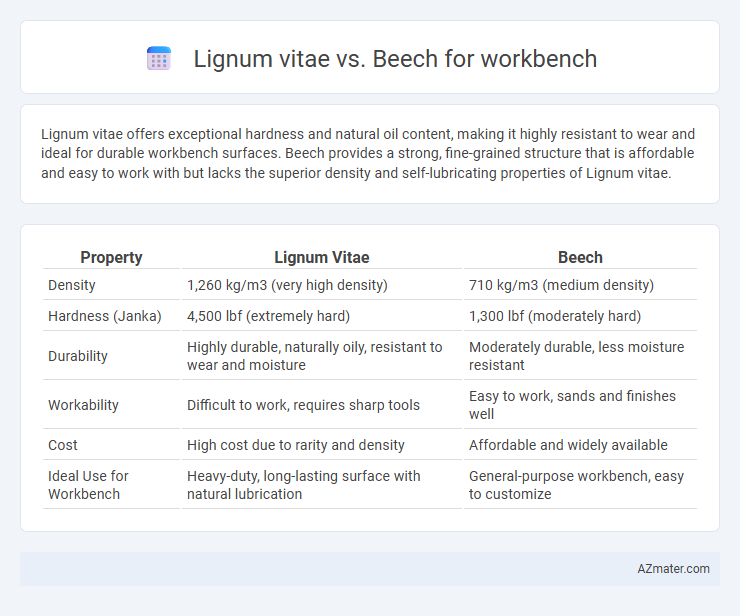Lignum vitae offers exceptional hardness and natural oil content, making it highly resistant to wear and ideal for durable workbench surfaces. Beech provides a strong, fine-grained structure that is affordable and easy to work with but lacks the superior density and self-lubricating properties of Lignum vitae.
Table of Comparison
| Property | Lignum Vitae | Beech |
|---|---|---|
| Density | 1,260 kg/m3 (very high density) | 710 kg/m3 (medium density) |
| Hardness (Janka) | 4,500 lbf (extremely hard) | 1,300 lbf (moderately hard) |
| Durability | Highly durable, naturally oily, resistant to wear and moisture | Moderately durable, less moisture resistant |
| Workability | Difficult to work, requires sharp tools | Easy to work, sands and finishes well |
| Cost | High cost due to rarity and density | Affordable and widely available |
| Ideal Use for Workbench | Heavy-duty, long-lasting surface with natural lubrication | General-purpose workbench, easy to customize |
Introduction to Lignum Vitae and Beech
Lignum vitae, known for its exceptional density and natural oils, offers superior durability and self-lubricating properties ideal for heavy-duty workbenches. Beech wood, characterized by its fine grain and hardness, provides a stable and smooth surface suitable for precision woodworking tasks. Comparing these woods highlights Lignum vitae's outstanding resistance to wear and moisture against Beech's balanced strength and affordability for general shop use.
Wood Properties: Lignum Vitae vs Beech
Lignum vitae boasts exceptional density and natural oils, providing superior hardness and self-lubricating properties ideal for workbench surfaces subjected to heavy use and moisture. Beech offers a fine, tight grain with moderate hardness and excellent shock resistance, making it a reliable, cost-effective option for general workbench construction. While Lignum vitae excels in durability and resistance to wear, Beech provides ease of machining and a consistent, smooth finish suitable for detailed woodworking tasks.
Durability and Hardness Comparison
Lignum vitae is significantly harder and more durable than beech, boasting a Janka hardness of approximately 4,500 lbf compared to beech's 1,300 lbf, making it highly resistant to wear and impact. Its natural oils provide excellent self-lubricating properties and superior resistance to moisture and decay, ideal for heavy-duty workbenches in demanding environments. Beech offers moderate hardness and durability suitable for general woodworking, but it lacks the extreme toughness and longevity found in lignum vitae.
Workability and Tool Compatibility
Lignum vitae offers exceptional workability due to its natural oils, which enhance tool compatibility by reducing friction and dulling during planing and sanding, making it ideal for heavy-duty workbench surfaces. Beech provides good workability with a fine, even grain that machines well and holds screws securely, ensuring stability for workbenches while maintaining compatibility with common woodworking tools. Both woods perform well with hand and power tools, but Lignum vitae's density demands sharper blades and slower feed rates compared to beech's more moderate hardness and easier machining characteristics.
Resistance to Wear and Moisture
Lignum vitae exhibits exceptional resistance to wear and moisture due to its natural oils and extreme density, making it ideal for heavy-duty workbench surfaces exposed to frequent use and humidity. Beech offers moderate wear resistance but is more prone to swelling and damage in moist environments, requiring proper sealing for durability. Choosing Lignum vitae ensures superior longevity and reduced maintenance for workbenches in demanding conditions.
Cost and Availability Analysis
Lignum vitae is significantly more expensive than beech due to its rarity and slow growth rate, resulting in limited availability and higher procurement costs. Beech wood offers a cost-effective alternative with widespread availability across Europe and North America, making it a popular choice for workbenches in terms of budget constraints. The dense, hard properties of lignum vitae provide superior durability, but beech's balance of hardness and easier sourcing supports practical affordability for large-scale or DIY workbench projects.
Aesthetic Appeal and Grain Patterns
Lignum vitae boasts a rich, dark brown color with striking greenish-black streaks, offering a unique and exotic aesthetic appeal compared to the pale, warm tones of beech wood. Its dense, interlocked grain pattern creates a smooth, polished surface that enhances the visual texture of a workbench, while beech exhibits a fine, straight grain with occasional waves, providing a more uniform and traditional appearance. The contrasting grain patterns between lignum vitae and beech significantly influence the workbench's visual impact and character, catering to different stylistic preferences.
Weight and Stability Considerations
Lignum vitae is significantly denser, with a specific gravity around 1.23, making it much heavier and more stable under heavy workloads compared to beech, which has a specific gravity near 0.72. The higher weight of lignum vitae enhances vibration dampening and overall stability, essential for precision work on a workbench. Beech offers moderate stability and is easier to move due to its lighter weight, but it may not absorb shocks as effectively during high-impact tasks.
Best Use Cases for Each Wood
Lignum vitae is ideal for heavy-duty workbenches requiring exceptional hardness, natural oiliness, and resistance to wear, making it perfect for metalworking and tool support. Beech excels in lighter-duty workbenches, valued for its affordability, uniform grain, and ease of machining, suitable for woodworking and general-purpose tasks. Both woods offer durability, but Lignum vitae's density supports heavy impacts, while Beech's workability benefits precise joinery and finishing.
Final Verdict: Choosing the Right Wood for Your Workbench
Lignum vitae stands out for its exceptional density and natural oils, offering superior durability and self-lubricating properties ideal for heavy-duty workbenches. Beech provides a more affordable and readily available option with good hardness and shock resistance, making it suitable for general woodworking tasks. For final verdict, choose lignum vitae for long-lasting, high-performance workbenches requiring minimal maintenance, while beech is optimal for budget-conscious projects demanding reliable strength and ease of use.

Infographic: Lignum vitae vs Beech for Workbench
 azmater.com
azmater.com